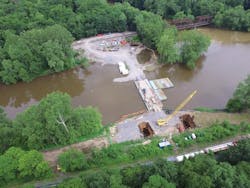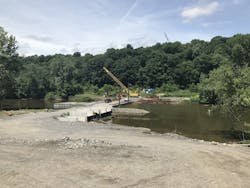Ellwood Water Treatment Plant
Cost: $80 million
Location: New Beaver Borough, Pa.
Year: 2018-12-01
Size: 8 mgd
Owner: Pennsylvania American Water Co.
Designers: Gannett Fleming Inc., Buchart Horn Inc.
Contractor: Reynolds Construction LLC, Mascaro Construction Company LP
The Ellwood Water Treatment Project was on a mission to replace the existing water treatment plant, which had met the end of its useful life. The plant was originally constructed in 1909 and expanded to the present rated capacity of 5.2 million gal per day in 1918. With the new plant, the project was looking to increase system capacity and reliability to support future demands.
The plant is located at the confluence of the Beaver River and Connoquenessing Creek in New Beaver Borough, Pa. The location provides an adequate amount of water and the added reliability of two sources of supply. The plant includes conventional treatment with inclined plate settlers and granular activated carbon filters. Chloramines were used for disinfection by-product control. Ultraviolet disinfection was provided for U.S. EPA LT2 compliance, and the units are capable of operating in an advanced oxidation mode for treatment of taste and odor.
The project came with many challenges. The acquisition of suitable property was difficult due to the steep terrain along the Beaver River and Connoquenessing Creek, the desire to have dual sources of supply and the encumbrance of many properties with shale gas leases.
The site is at the top of a steep embankment approximately 140 ft above the Beaver River. Additionally, multiple railroad tracks are located between the plant and the sources of supply.
“The water treatment plant structures are located on a flat area at the top of the embankment, so there were no concerns constructing there other than the increased cost and complexity of construction to get the water from the rivers below up to the treatment plant,” said Scott Thomas, senior project manager for Pennsylvania American Water.
The original design included a separate raw water pump station on an adjacent property closer to the sources and at a lower grade elevation. A permanent crossing for long-term access to the site could not be obtained from the railroad, so the pump station had to be relocated to the water treatment plant site. This redesign effort incorporated the use of a construction management at risk bid approach for the intake portion of the project. In addition to the design challenges, multiple permits needed to be revised.
The location of the water pump station at the top of a steep embankment with two railroad tracks between it and the Beaver river required the construction of a deep caisson approximately 30 ft in diameter by 160 ft deep. The caisson contains vertical turbine pumps to supply the raw water to the treatment plant.
“The advantage of the water treatment plant site location is that it is well above any potential flooding other than the intakes themselves,” Thomas said.
At the bottom of the caisson, microtunnelling was utilized to install 60-in. and 75-in. bores, each approximately 530 ft long, to the Beaver River. The bores contain multiple 24-in. pipes for the dual intakes, a 24-in. finished water main and a 16-in. NPDES wastewater pipe. On the opposite side of the Beaver River, permanent easements had to be obtained from the property owner for the installation of the Connoquenssing Creek intake piping and 24-in. finished water main.
The piping had to cross under another railroad track on this side of the river. The property has historical significance, and archaeological artifacts were identified during the design stage. Open-cut installation of the piping would have required significant archaeological studies, and a bore would be required for the railroad crossing regardless. This section of piping is being installed by microtunnelling in a 75-in. bore with approximately 410 ft of finished water main to avoid additional archaeological artifacts.
In addition to three sets of railroad tracks above that affected the raw water facilities, underground crossings were required for a 16-in. finished water main and a 24-in. finished water main. The multiple railroad tracks on the project work sites required close coordination with the railroads and numerous below-grade crossing agreements, temporary at-grade crossing agreements, blasting approval for the caisson construction and multiple full time flaggers as required by the railroads.
In addition to the permanent pipeline crossings, these railroads impacted construction access. Entry to the site for construction required the contractor to cross over or under a set of railroad tracks. During the design stage, the railroad implied that access under the Connoquenssing Creek bridge would be allowed. However, after the construction contract was awarded, the railroad denied this access and required the contractor to cross the tracks at grade. This required significant changes to the site grading to cross the elevated tracks and required modification of multiple permits, including Erosion and Sedimentation Control and Water Obstruction and Encroachment permits.
Construction progress of the boring and receiving pits along the Beaver River and Connoquenssing Creek were impacted by frequent flooding that occurred on these waterways. Between fall 2017 and spring 2018, 12 flood events occurred.
“Flooding has not impacted the construction of the water treatment plant structures, but it has significantly impacted tunneling, piping, and intake construction in the river valley below a number of times during the ongoing construction,” Thomas said.
Additionally, the Indiana bat was identified as an endangered species that could be impacted by the project. Permits dictated that any tree cutting needed to be performed between Nov. 15 and March 31.
“This potential impact was identified by state regulators during the permitting stage,” Thomas said.
Some of the trees were able to be removed during this time period, but some could not be removed due to the modifications of the Erosion and Sedimentation Control and Water Obstruction and Encroachment permits noted previously. Special bat emergence surveys by an environmental consultant were required to ensure that no bats were present prior to tree cutting after March 31. No bats were found, and the project was able to continue.
Project Year: 2018-12-01Contractor: Reynolds Construction LLC, Mascaro Construction Company LP Designers: Gannett Fleming Inc., Buchart Horn Inc.Owner: Pennsylvania American Water Co.Location: New Beaver Borough, Pa. Cost: $80 millionSize: 8 mgd

